engine Peugeot Expert Tepee 2011 Owner's Guide
[x] Cancel search | Manufacturer: PEUGEOT, Model Year: 2011, Model line: Expert Tepee, Model: Peugeot Expert Tepee 2011Pages: 268, PDF Size: 9.78 MB
Page 64 of 268
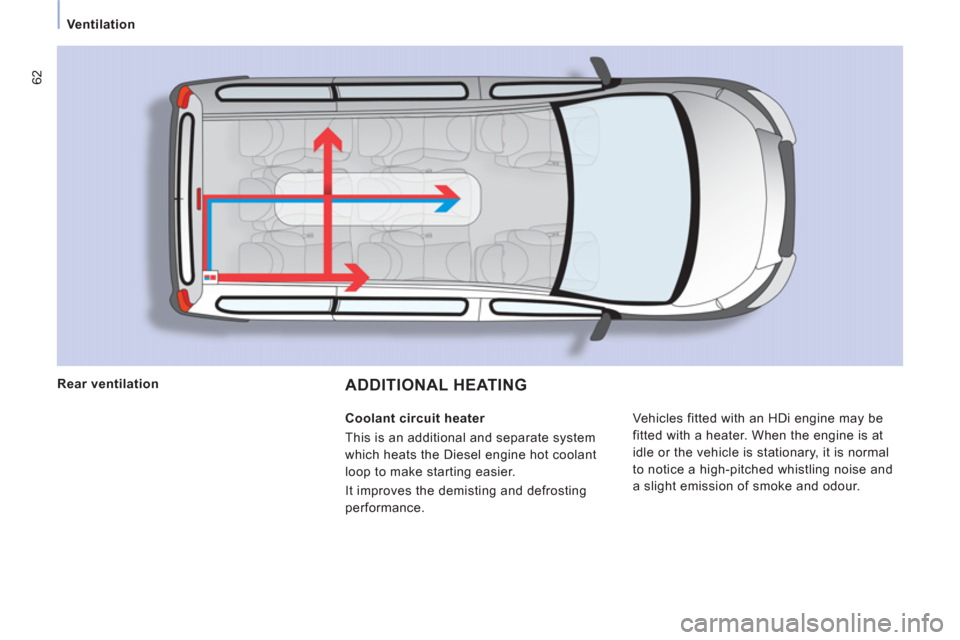
62
Ventilation
ADDITIONAL HEATING
Vehicles fitted with an HDi engine may be
fitted with a heater. When the engine is at
idle or the vehicle is stationary, it is normal
to notice a high-pitched whistling noise and
a slight emission of smoke and odour.
Rear ventilation
Coolant circuit heater
This is an additional and separate system
which heats the Diesel engine hot coolant
loop to make starting easier.
It improves the demisting and defrosting
performance.
Page 95 of 268
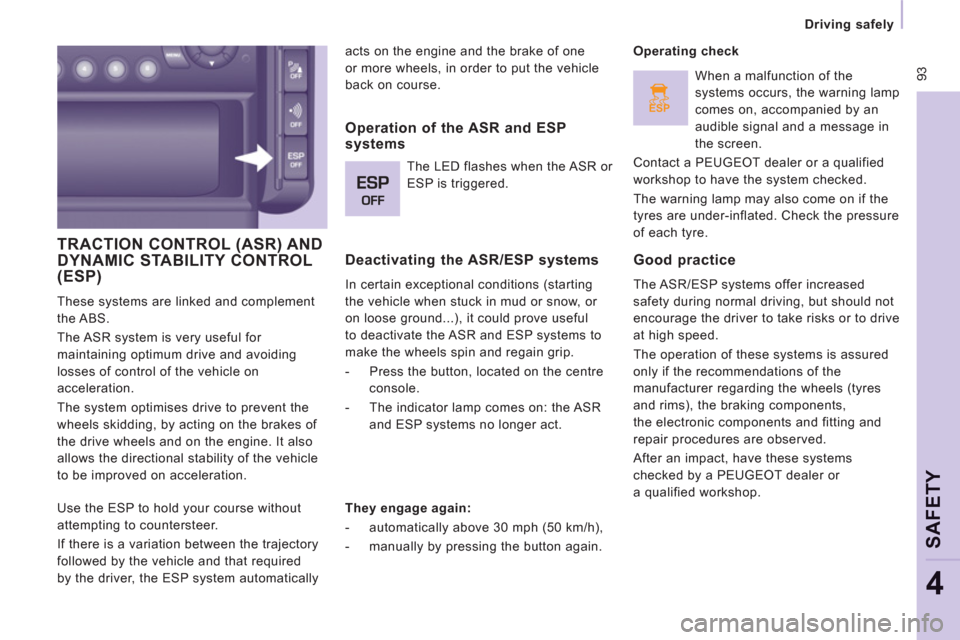
ESP
93
Driving safely
SAFETY
4
TRACTION CONTROL (ASR) AND DYNAMIC STABILITY CONTROL(ESP)
These systems are linked and complement
the ABS.
The ASR system is very useful for
maintaining optimum drive and avoiding
losses of control of the vehicle on
acceleration.
The system optimises drive to prevent the
wheels skidding, by acting on the brakes of
the drive wheels and on the engine. It also
allows the directional stability of the vehicle
to be improved on acceleration. acts on the engine and the brake of one
or more wheels, in order to put the vehicle
back on course.
Deactivating the ASR/ESP systems
In certain exceptional conditions (starting
the vehicle when stuck in mud or snow, or
on loose ground...), it could prove useful
to deactivate the ASR and ESP systems to
make the wheels spin and regain grip.
- Press the button, located on the centre
console.
- The indicator lamp comes on: the ASR
and ESP systems no longer act.
Operating check
Good practice
The ASR/ESP systems offer increased
safety during normal driving, but should not
encourage the driver to take risks or to drive
at high speed.
The operation of these systems is assured
only if the recommendations of the
manufacturer regarding the wheels (tyres
and rims), the braking components,
the electronic components and fitting and
repair procedures are observed.
After an impact, have these systems
checked by a PEUGEOT dealer or
a qualified workshop.
Operation of the ASR and ESPsystems
The LED flashes when the ASR or
ESP is triggered.
They engage again:
- automatically above 30 mph (50 km/h),
- manually by pressing the button again.
When a malfunction of the
systems occurs, the warning lamp
comes on, accompanied by an
audible signal and a message in
the screen.
Contact a PEUGEOT dealer or a qualified
workshop to have the system checked.
The warning lamp may also come on if the
tyres are under-inflated. Check the pressure
of each tyre.
Use the ESP to hold your course without
attempting to countersteer.
If there is a variation between the trajectory
followed by the vehicle and that required
by the driver, the ESP system automatically
Page 111 of 268

109
Towing a trailer
ACCE
SS
ORIE
S
5
For more information about weights,
refer to the administrative documents
(V5 registration document, ...) or to the
"Weights" section of chapter 8.
TOWING A TRAILER, CARAVAN, BOAT, ETC...
Distribution of loads
Distribute the load in the trailer so that the
heaviest objects are as close as possible
to the axle and the nose weight is close to
the maximum authorised without, however,
exceeding it.
Cooling
Towing a trailer on a slope increases the
coolant temperature.
As the fan is electrically controlled, its
cooling capacity is not dependent on the
engine speed.
Driving advice
A towed vehicle must free wheel: gearbox in
neutral.
Page 112 of 268

11 0
Towing a trailer
On the contrary, use a high gear to lower the
engine speed and reduce your speed.
In all cases, pay attention to the coolant
temperature. Tyres: check the tyre pressures of the
towing vehicle (see the "Identification
markings" section of chapter 8) and of
the trailer, observing the recommended
pressures.
Towbar
We recommend the use of genuine
PEUGEOT towbars and their harnesses,
which have been tested and approved from
the design stage of your vehicle, and that
you entrust the fitting of this equipment to a
PEUGEOT dealer.
If this equipment is not fitted by a PEUGEOT
dealer, it is imperative that it is fitted using
the electrical pre-equipment installed at the
rear of the vehicle and in accordance with
the manufacturer's instructions.
In accordance with the general instructions
a reminder of which has been given above,
we draw your attention to the risk associated
with fitting a towbar or electrical accessory
not recommended by PEUGEOT. Fitting
such equipment could result in the failure
of your vehicle's electronic system. Please
obtain information from the Manufacturer
before fitting this type of equipment. If the coolant temperature warning
lamp comes on, stop the vehicle
and switch off the engine as soon
as possible.
Good Practice
In certain cases of particularly arduous
use (towing the maximum load up a steep
slope in high temperatures), the engine
automatically limits its power. In this
case, the air conditioning is automatically
cut off to save engine power.
See the "Levels" section of chapter 6.
Brakes
Towing increases the braking distance. Drive
at a moderate speed, change down early
and brake gradually.
Side wind
Sensitivity to side wind is increased. Drive
smoothly and at a moderate speed.
ABS/ESP
The ABS or ESP systems only control the
vehicle, not the trailer or caravan.
Rear parking sensors
The parking sensors system does not
function while the vehicle is towing.
Page 113 of 268
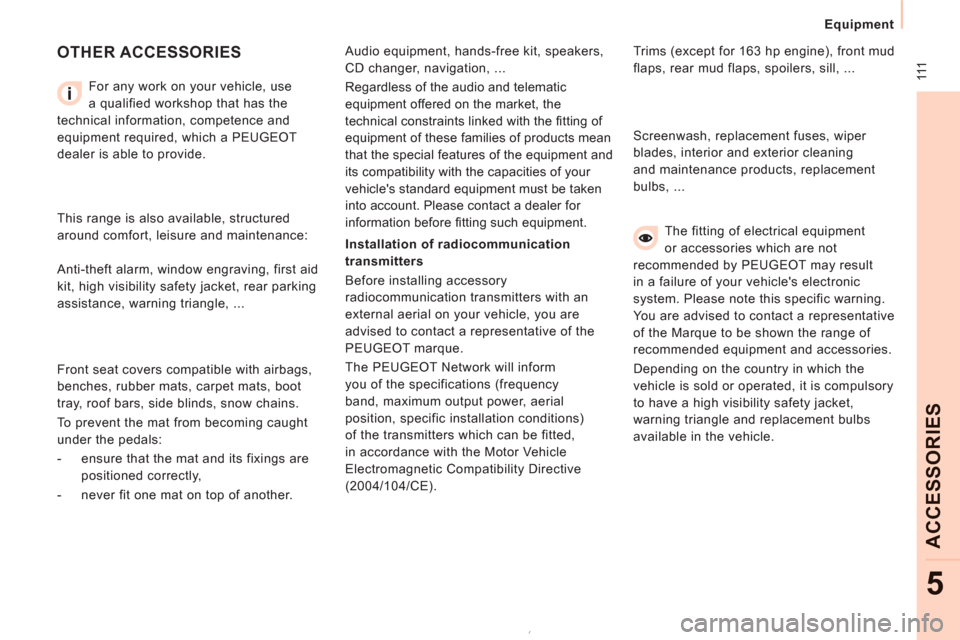
111
Equipment
ACCE
SS
ORIE
S
5
OTHER ACCESSORIES
Installation of radiocommunication
transmitters
Before installing accessory
radiocommunication transmitters with an
external aerial on your vehicle, you are
advised to contact a representative of the
PEUGEOT marque.
The PEUGEOT Network will inform
you of the specifications (frequency
band, maximum output power, aerial
position, specific installation conditions)
of the transmitters which can be fitted,
in accordance with the Motor Vehicle
Electromagnetic Compatibility Directive
(2004/104/CE).
This range is also available, structured
around comfort, leisure and maintenance: Trims (except for 163 hp engine), front mud
flaps, rear mud flaps, spoilers, sill, ... Audio equipment, hands-free kit, speakers,
CD changer, navigation, ...
Regardless of the audio and telematic
equipment offered on the market, the
technical constraints linked with the fi tting of
equipment of these families of products mean
that the special features of the equipment and
its compatibility with the capacities of your
vehicle's standard equipment must be taken
into account. Please contact a dealer for
information before fi tting such equipment.
Front seat covers compatible with airbags,
benches, rubber mats, carpet mats, boot
tray, roof bars, side blinds, snow chains.
To prevent the mat from becoming caught
under the pedals:
- ensure that the mat and its fixings are
positioned correctly,
- never fit one mat on top of another. Screenwash, replacement fuses, wiper
blades, interior and exterior cleaning
and maintenance products, replacement
bulbs, ...
The fitting of electrical equipment
or accessories which are not
recommended by PEUGEOT may result
in a failure of your vehicle's electronic
system. Please note this specific warning.
You are advised to contact a representative
of the Marque to be shown the range of
recommended equipment and accessories.
Depending on the country in which the
vehicle is sold or operated, it is compulsory
to have a high visibility safety jacket,
warning triangle and replacement bulbs
available in the vehicle.
For any work on your vehicle, use
a qualified workshop that has the
technical information, competence and
equipment required, which a PEUGEOT
dealer is able to provide.
Anti-theft alarm, window engraving, first aid
kit, high visibility safety jacket, rear parking
assistance, warning triangle, ...
Page 114 of 268

Opening the bonnet
OPENING THE BONNET
From inside:
- lift the cover located at the foot of the
front left seat.
- pull the control upwards.
To close
Lower the bonnet and release it at the end of its
travel. Check that the bonnet is properly locked.
From outside:
partially open the bonnet,
lift the catch and raise the bonnet.
Bonnet strut
Secure the strut in one of the two notches,
according to the height required, to hold
the bonnet open.
Before closing the bonnet, replace the strut
in its housing.
"Bonnet open" warning
This warning is linked to the alarm option
only.
With the engine running or the
vehicle moving, a warning light
and a diagram on the display,
accompanied by an audible
signal, warn you that the bonnet
is not properly closed.
Page 115 of 268
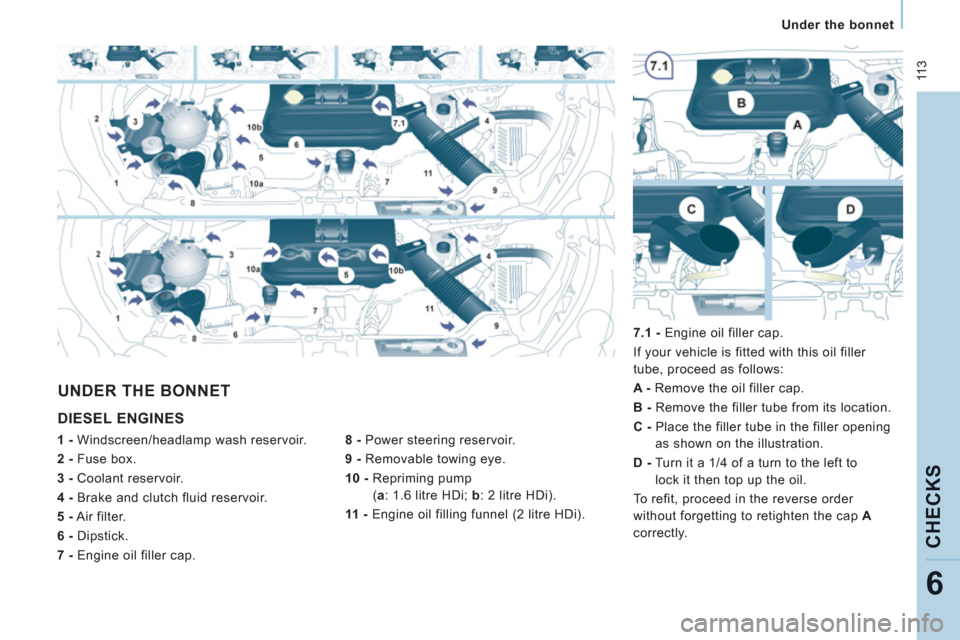
11 3
Under the bonnet
CHECK
S
6
DIESEL ENGINES
8 -
Power steering reservoir.
9 -
Removable towing eye.
10 -
Repriming pump
( a
: 1.6 litre HDi; b
: 2 litre HDi).
11 -
Engine oil filling funnel (2 litre HDi).
UNDER THE BONNET
1 -
Windscreen/headlamp wash reservoir.
2 -
Fuse box.
3 -
Coolant reservoir.
4 -
Brake and clutch fluid reservoir.
5 -
Air filter.
6 -
Dipstick.
7 -
Engine oil filler cap.
7.1 -
Engine oil filler cap.
If your vehicle is fitted with this oil filler
tube, proceed as follows:
A -
Remove the oil filler cap.
B -
Remove the filler tube from its location.
C -
Place the filler tube in the filler opening
as shown on the illustration.
D -
Turn it a 1/4 of a turn to the left to
lock it then top up the oil.
To refit, proceed in the reverse order
without forgetting to retighten the cap A
correctly.
Page 116 of 268

11 4
Under the bonnet
PETROL ENGINE
4.
Brake and clutch fluid reservoir.
5.
Air filter.
6.
Dipstick.
1.
Windscreen/headlamp wash reservoir.
2.
Fuse box.
3.
Coolant reservoir.
7.
Engine oil filler cap.
8.
Power steering reservoir.
9.
Removable towing eye.
Page 117 of 268
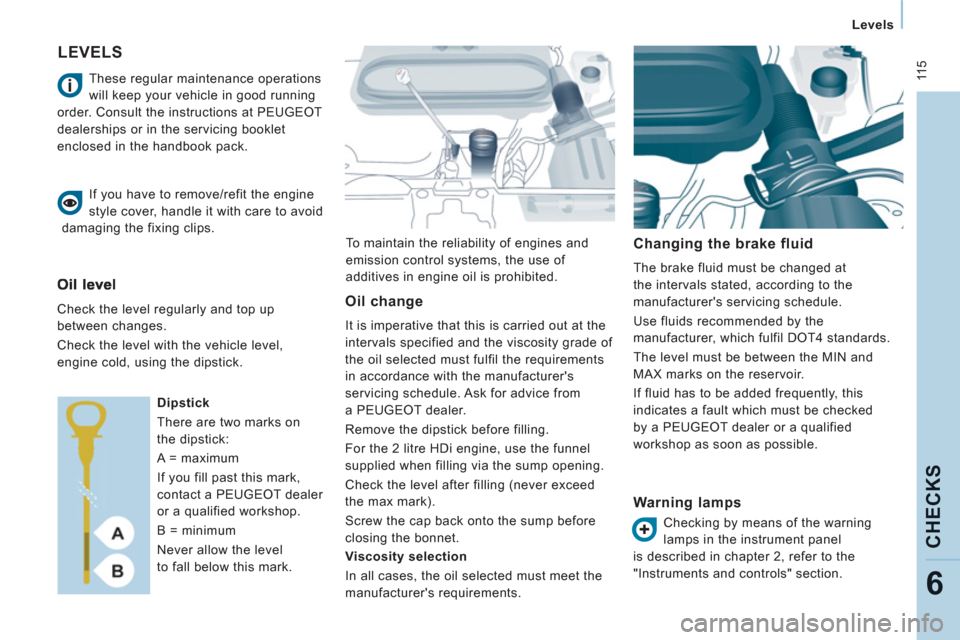
11 5
Levels
CHECK
S
6
LEVELS
To maintain the reliability of engines and
emission control systems, the use of
additives in engine oil is prohibited.
Changing the brake fluid
The brake fluid must be changed at
the intervals stated, according to the
manufacturer's servicing schedule.
Use fluids recommended by the
manufacturer, which fulfil DOT4 standards.
The level must be between the MIN and
MAX marks on the reservoir.
If fluid has to be added frequently, this
indicates a fault which must be checked
by a PEUGEOT dealer or a qualified
workshop as soon as possible. These regular maintenance operations
will keep your vehicle in good running
order. Consult the instructions at PEUGEOT
dealerships or in the servicing booklet
enclosed in the handbook pack.
If you have to remove/refit the engine
style cover, handle it with care to avoid
damaging the fixing clips.
Check the level regularly and top up
between changes.
Check the level with the vehicle level,
engine cold, using the dipstick.
Dipstick
There are two marks on
the dipstick:
A = maximum
If you fill past this mark,
contact a PEUGEOT dealer
or a qualified workshop.
B = minimum
Never allow the level
to fall below this mark. Oil change
It is imperative that this is carried out at the
intervals specified and the viscosity grade of
the oil selected must fulfil the requirements
in accordance with the manufacturer's
servicing schedule. Ask for advice from
a PEUGEOT dealer.
Remove the dipstick before filling.
For the 2 litre HDi engine, use the funnel
supplied when filling via the sump opening.
Check the level after filling (never exceed
the max mark).
Screw the cap back onto the sump before
closing the bonnet.
Viscosity selection
In all cases, the oil selected must meet the
manufacturer's requirements.
Warning lamps
Checking by means of the warning
lamps in the instrument panel
is described in chapter 2, refer to the
"Instruments and controls" section.
Page 118 of 268
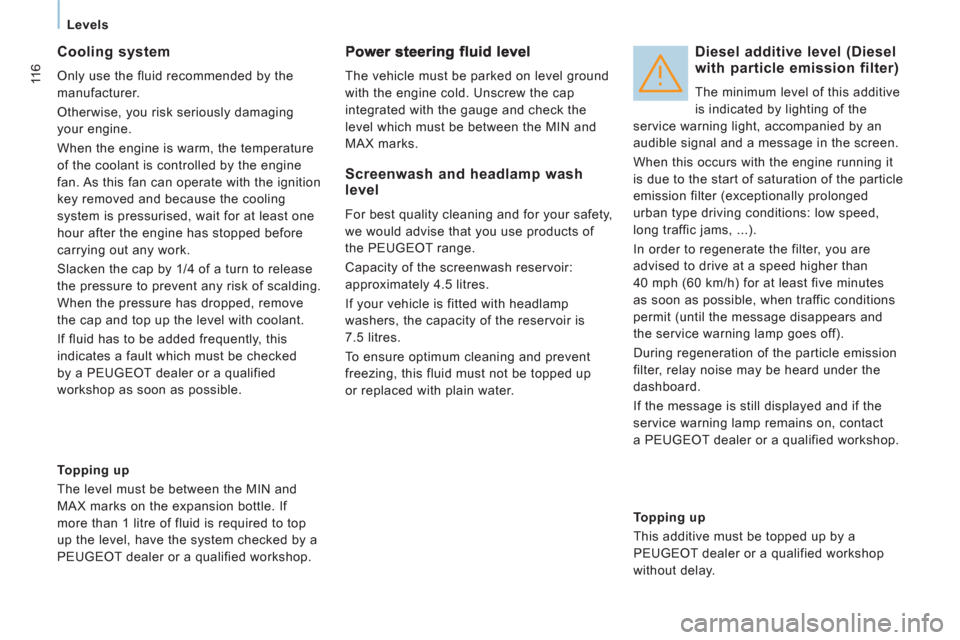
11 6
Levels
Cooling system
Only use the fluid recommended by the
manufacturer.
Otherwise, you risk seriously damaging
your engine.
When the engine is warm, the temperature
of the coolant is controlled by the engine
fan. As this fan can operate with the ignition
key removed and because the cooling
system is pressurised, wait for at least one
hour after the engine has stopped before
carrying out any work.
Slacken the cap by 1/4 of a turn to release
the pressure to prevent any risk of scalding.
When the pressure has dropped, remove
the cap and top up the level with coolant.
If fluid has to be added frequently, this
indicates a fault which must be checked
by a PEUGEOT dealer or a qualified
workshop as soon as possible. The vehicle must be parked on level ground
with the engine cold. Unscrew the cap
integrated with the gauge and check the
level which must be between the MIN and
MAX marks.
Diesel additive level (Diesel
with particle emission filter)
The minimum level of this additive
is indicated by lighting of the
service warning light, accompanied by an
audible signal and a message in the screen.
When this occurs with the engine running it
is due to the start of saturation of the particle
emission filter (exceptionally prolonged
urban type driving conditions: low speed,
long traffic jams, ...).
In order to regenerate the filter, you are
advised to drive at a speed higher than
40 mph (60 km/h) for at least five minutes
as soon as possible, when traffic conditions
permit (until the message disappears and
the service warning lamp goes off).
During regeneration of the particle emission
filter, relay noise may be heard under the
dashboard.
If the message is still displayed and if the
service warning lamp remains on, contact
a PEUGEOT dealer or a qualified workshop.
Topping up
The level must be between the MIN and
MAX marks on the expansion bottle. If
more than 1 litre of fluid is required to top
up the level, have the system checked by a
PEUGEOT dealer or a qualified workshop.
Screenwash and headlamp wash level
For best quality cleaning and for your safety,
we would advise that you use products of
the PEUGEOT range.
Capacity of the screenwash reservoir:
approximately 4.5 litres.
If your vehicle is fitted with headlamp
washers, the capacity of the reservoir is
7.5 litres.
To ensure optimum cleaning and prevent
freezing, this fluid must not be topped up
or replaced with plain water.
Topping up
This additive must be topped up by a
PEUGEOT dealer or a qualified workshop
without delay.